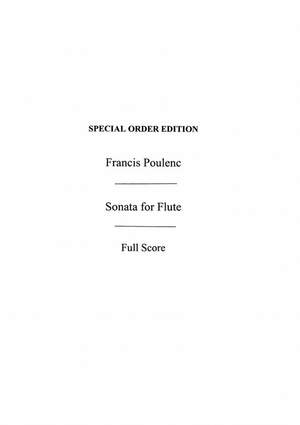Francis Poulenc Flute Sonata
The in-turn breathy sensuousness and penetrating brilliance of the flute, an instrument beloved by French composers, are perfect timbral qualities for music by Poulenc. No French composer epitomized the elegance, clarity, and droll wit of the 20th-century Gallic spirit better than Poulenc, and it is not surprising that he came around to expressing these national characteristics in a work for an instrument that can delineate them so well.

The Flute Sonata is as typical of Poulenc as anything he ever wrote, combining as it does elegant charm and brashness, and embodying a disarming combination of innocence and sophistication and a naturalness that seems to stem directly from the boulevard cafés. Although titled ‘sonata,’ the piece makes no pretense of being one formally -- none of the three movements is in sonata form -- nor does it make any effort at instrumental equality: the flute is frankly the star, with the keyboard cast in a supporting role.
The first movement is in simple three-part form. The main idea’s rather pensive character is contrasted with a middle theme that has an early-Debussy sweetness, and both melodies have nothing in common temperamentally with a brief flute outburst that occurs near the beginning of the movement and never returns. The song-like middle movement is so Parisian-caféish, it could easily have (French) boy-girl-moon-June lyrics.

This Sonata For Flute and Piano is a virtuosic flute solo by renowned influential French composer Francis Poulenc. Written in 1956-57, this is an elegant, dreamy chamber work and he has demonstrated his obvious compositional skill, also highlighting the French affinity with the sweet sounds of the flute. From the Publisher. If Poulenc's musical debt in his late woodwind sonatas is rather to Stravinsky - as the chromatic inflexions of the 'Cantilena' or the bustling neo-classicism in the finale of his Flute Sonata show - then the plan to write a series of chamber sonatas surely stems from Debussy's similar scheme in 1915-1917.And if he was trying, like Debussy, to confirm his. By Francis Poulenc. 1 PREVIEW Flute Sonata, FP 164: II. By Francis Poulenc. 2 PREVIEW Flute Sonata, FP 164: III. By Francis Poulenc. The Sonata for Flute and Piano (1957) further solidified Poulenc’s connection with the United States. Poulenc dedicated the Sonata to the memory of Elizabeth Sprague Coolidge, and American chamber music patron. The Coolidge Foundation contacted Poulenc in 1956 and offered him a commission for a piece of chamber music.
Having sung his tender song, Poulenc devises a virtuosic finale that is nearly all one big elbow in the ribs. Not only is the main theme as frivolous as possible, but the movement is shot through with a very brief snatch of Bach’s Badinerie (from the Suite No. 2), and quotes of the first movement’s main and secondary themes.
Everyone knows that Poulenc can be, among other things, suave, sensuous, and slapstick; the Flute Sonata is a three-movement confirmation of this character description.
Orrin Howard, who annotated Los Angeles Philharmonic programs for more than 20 years while serving the Orchestra as Director of Publications and Archives, continues to contribute regularly to the Philharmonic’s program book.
Francis Poulenc wrote his Sonate pour flûte et piano in 1957 in response to a commission from the Elizabeth Sprague Coolidge Foundation at the U.S. Library of Congress. The work is dedicated to the memory of Coolidge, one of the twentieth century’s greatest champions of chamber music.
A sense of restless melancholy pervades the first movement (Allegretto malincolico) of Poulenc’s Sonata. It opens with an expansive melody filled with delightfully unexpected twists and turns. Often, this music seems to glance back at the elegant lines of baroque and classical music. At the same time, it pays homage to a distinctly French clarity. While working on the Sonata, Pouenc wrote in a letter to his friend, Pierre Bernac,
In working on this Flute Sonata I have the feeling of going back a long way, but with a more settled technique. It’s a sonata of Debussyan dimensions. It’s the French sense of balance [la mesure française]. Finding the form for your language is the most difficult thing. It’s what Webern has in the highest degree … and what Boulez has not yet found.
Francis Poulenc Clarinet Sonata
The second movement (Cantilena) is serene and songlike. It has been described as “‘a great rainbow of melody.” The final movement (Presto giocoso) is an exuberant romp filled with witty neoclassical caricatures. Listen for the moment when all of the frolicking forward motion halts in a brief pause, followed by a plaintive remembrance of a theme from the first movement.
Francis Poulenc Sonata For Flute And Piano
Earlier this week the Frankfurt Radio Symphony released this performance, featuring their superstar principal flutist, Clara Andrada de la Calle with pianist Maria Ollikainen. The online concert was recorded on May 25. Following the Poulenc, we hear the episodic Ballade for Flute and Piano by the Swiss composer, Frank Martin (1890-1974).